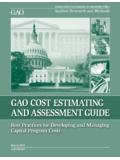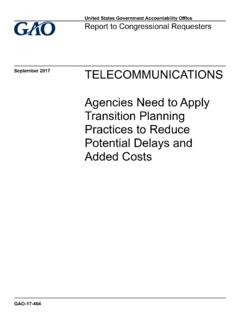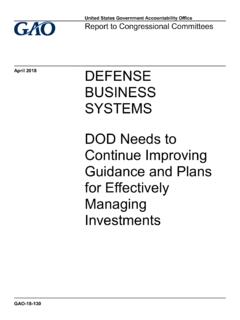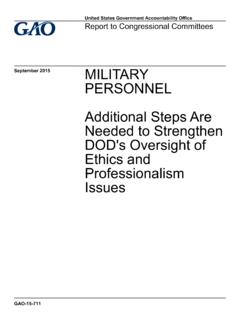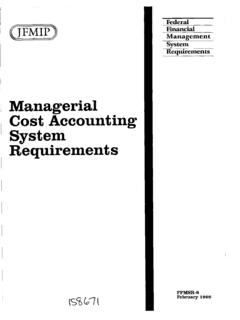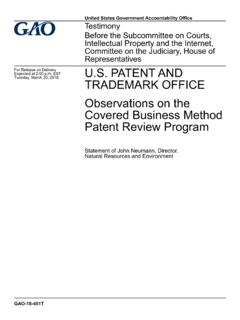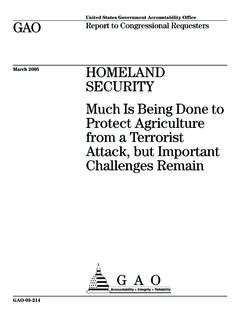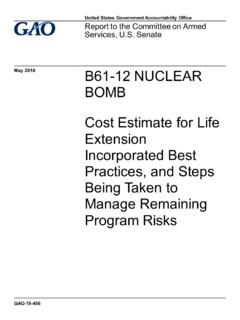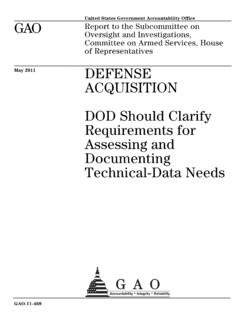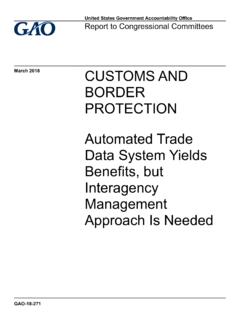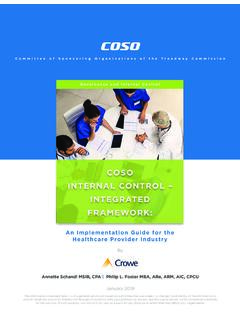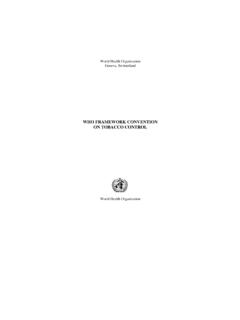Transcription of GAO-15-593SP, A Framework for Managing Fraud Risks in ...
1 A Framework for Managing Fraud Risks in Federal ProgramsJuly 2015 GAO-15-593 SPSource: GAO. | GAO-15-593 SPEvaluate outcomes using a risk-based approach and adapt activities to improve Fraud risk management. Conduct risk-based monitoring and evaluation of Fraud risk management activities with a focus on outcome measurement. Collect and analyze data from reporting mechanisms and instances of detected Fraud for real-time monitoring of Fraud trends. Use the results of monitoring, evaluations, and investigations to improve Fraud prevention, detection, and and implement a strategy with specific control activities to mitigate assessed Fraud Risks and collaborate to help ensure effective , document, and communicate an antifraud strategy, focusing on preventive control the benefits and costs of controls to prevent and detect potential Fraud , and develop a Fraud response plan.
2 Establish collaborative relationships with stakeholders and create incentives to help ensure effective implementation of the antifraud to combating Fraud by creating an organizational culture and structure conducive to Fraud risk a senior-level commitment to combat Fraud and involve alllevels of the program in setting an antifraud an entity within the program office to lead Fraud risk management the entity has defined responsibilities and the necessary authority to serve its role. Plan regular Fraud risk assessments and assess Risks to determine a Fraud risk the Fraud risk assessment to the program, and involve relevant stakeholders.
3 Assess the likelihood and impact of Fraud Risks and determine risk tolerance. Examine the suitability of existing controls, prioritize residual Risks , and document a Fraud risk AND FEEDBACKMONITORING AND FEEDBACKP reventionDetectionResponseEVALUATE AND ADAPTDESIGN AND IMPLEMENTCOMMITASSESSA Framework for Managing Fraud Risks in Federal ProgramsJuly 2015 Highlights of GAO-15-593SP, a Framework for Managing Fraud RisksThe Fraud Risk Management Framework and Selected Leading Practices To help managers combat Fraud and preserve integrity in government agencies and programs.
4 GAO identified leading practices for Managing Fraud Risks and organized them into a conceptual Framework called the Fraud Risk Management Framework (the Framework ). The Framework encompasses control activities to prevent, detect, and respond to Fraud , with an emphasis on prevention, as well as structures and environmental factors that influence or help managers achieve their objective to mitigate Fraud Risks . In addition, the Framework highlights the importance of monitoring and incorporating feedback, which are ongoing practices that apply to all four of the components described below.
5 What GAO FoundWhy GAO Did This StudyFraud poses a significant risk to the integrity of federal programs and erodes public trust in government. Managers of federal programs maintain the primary responsibility for enhancing program integrity. Legislation, guidance by the Office of Management and Budget (OMB), and new internal control standards have increasingly focused on the need for program managers to take a strategic approach to Managing improper payments and Risks , including Fraud . Moreover, GAO s prior reviews highlight opportunities for federal managers to take a more strategic, risk-based approach to Managing Fraud Risks and developing effective antifraud controls.
6 Proactive Fraud risk management is meant to facilitate a program s mission and strategic goals by ensuring that taxpayer dollars and government services serve their intended purposes. The objective of this study is to identify leading practices and to conceptualize these practices into a risk-based Framework to aid program managers in Managing Fraud Risks . To address this objective, GAO conducted three focus groups consisting of antifraud professionals. In addition, GAO interviewed federal Offices of Inspector General (OIG), national audit institutions from other countries, the World Bank, the Organisation for Economic Co-operation and Development, as well as antifraud experts representing private companies, state and local audit associations, and nonprofit entities.
7 GAO also conducted an extensive literature review and obtained independent validation of leading practices from program officials. View GAO-15-593SP. For more information, contact Steve Lord at (202) 512-6722 or Foreword 1 Introduction 2A Framework for Effective Fraud Risk Management 51. Commit to Combating Fraud by Creating an Organizational Culture and Structure Conducive to Fraud Risk Management 8 Create an Organizational Culture to Combat Fraud at All Levels of the Agency 9 Create a Structure with a Dedicated Entity to Lead Fraud Risk Management Activities 102.
8 Plan Regular Fraud Risk Assessments and Assess Risks to Determine a Fraud Risk Profile 11 Plan Regular Fraud Risk Assessments That Are Tailored to the Program 12 Identify and Assess Risks to Determine the Program s Fraud Risk Profile 123. Design and Implement a Strategy with Specific Control Activities to Mitigate Assessed Fraud Risks and Collaborate to Help Ensure Effective Implementation 17 Determine Risk Responses and Document an Antifraud Strategy Based on the Fraud Risk Profile 18 Design and Implement Specific Control Activities to Prevent and Detect Fraud 20 Develop a Plan Outlining How the Program Will Respond to Identified Instances of Fraud 25 Establish Collaborative Relationships
9 With Stakeholders and Create Incentives to Help Ensure Effective Implementation of the Antifraud Strategy 254. Evaluate Outcomes Using a Risk-Based Approach and Adapt Activities to Improve Fraud Risk Management 28 Conduct Risk-Based Monitoring and Evaluate All Components of the Fraud Risk Management Framework 29 Monitor and Evaluate Fraud Risk Management Activities with a Focus on Measuring Outcomes 30 Adapt Fraud Risk Management Activities and Communicate the Results of Monitoring and Evaluations 31 Appendix I.
10 Objective, Scope, and Methodology 33 Appendix II: Challenges Related to Measuring Fraud 36 Appendix III: Examples of Control Activities and Additional Information on Leading Practices for Data Analytics and Fraud -Awareness Initiatives 37 Appendix IV: Risk Factors for Assessing Improper-Payment Risk 44 Appendix V: Example of a Fraud Risk Profile 45 Appendix VI: Endnotes 47 Appendix VII: GAO Contact and Staff Acknowledgments 55A Framework for Managing Fraud Risks in Federal Programs GAO-15-593 SPiiAbbreviationsACFE Association of Certified Fraud Examiners CMS Centers for Medicare & Medicaid ServicesCOSO Committee of Sponsoring Organizations of the Treadway CommissionCPI Center for Program IntegrityDOE Department of EnergyERM enterprise risk managementFAR Federal Acquisition RegulationFPS Fraud Prevention SystemFramework GAO s Fraud Risk Management FrameworkHHS Department of
